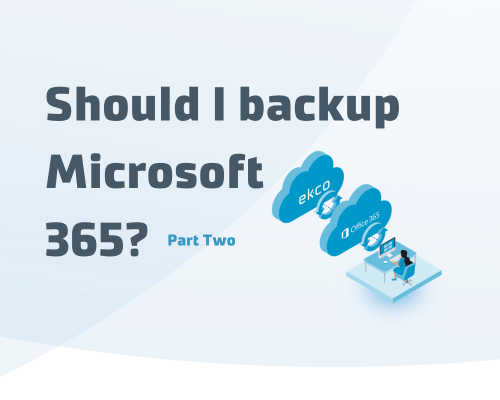
Should I backup Microsoft 365? Part 2 of 2
In Part 2, we discuss Versioning within Microsoft 365 and present the case for using a third party backup provider.

In part one of our Microsoft 365 Backup blog, we covered retention policies and where deleted items are stored. It’s safe to say that while there are some instances where you will be able to restore files, retention periods are normally in or around 30-90 days. Since the average length of time from a data compromise to discovery is over 140 days, this retention period is too narrow to rely on as a long term backup solution.
Before we jump into making the case to outsource to a third party backup provider, let’s discuss versioning.
Versioning
When versioning is activated, it saves different versions of your data. How this works in operation is again different for mail and SharePoint.
SharePoint
Versioning here can be activated separately from retention. Versioning can also be activated for subscriptions where retention cannot be used. The image below highlights what setting options there are for versioning within SharePoint.

For mail, the option of versioning is linked to retention in the case of mail. Versioning for mail is therefore only available for people who use an E3, E5 or Exchange Online 2 subscription.
Once retention is activated, versions of a mail item are automatically saved in the following instances:
- Subject of a mailbox item changes
- The body of a mailbox item changes
- An attachment is added to a mailbox item or removed from a mailbox item
- Senders or recipients are added to a mailbox item
- The sent or received date of a mailbox item is changed
Restore Process
The most important part of a backup is, of course, the restore process.
It’s not possible to restore files in bulk when using standard tools in Sharepoint. This means that you are unable to recover from ransomware attacks with the standard tools. While there are developers that make Powershell scripts available to perform bulk recovery, these are not supported by Microsoft.
It also is important to note that for mail, it is not possible to perform a so-called point in time restore.
Why Choose Ekco for your Microsoft 365 Backup Solution
Although Microsoft 365 offers some capabilities to retrieve data, we can conclude that these are not sufficient to secure data in every situation.
Here’s 8 reasons to choose Ekco to protect your Microsoft 365 data.
- Enable data restoration in the event of corruption of a mailbox or a site
- Meet minimum legal requirements for organisations
- Retain data forever, not just the standard retention periods with Microsoft (30 days for email, 90 days for SharePoint)
- Monitor all your backups from one centralised portal. This helps you keep track of storage, generate reports and self-provision new mailboxes.
- 100% Ransomware Proof. Microsoft 365 does not offer a bulk point-in-time restore option meaning you have no protection from ransomware as standard
- With email, you can only select a date based on the email creation date
- With SharePoint, you can only restore a file
- Low and guaranteed RTO. Microsoft 365 often uses tools that are not primarily developed for backup and restore purposes. As a result, it can sometimes be cumbersome and time-consuming to use the tools, which does not benefit the RTO.
- E3 or E5 subscription options (for longer retention within Microsoft 365) cost much more than a Business Premium subscription and a 3rd-party backup tool.
- Access to your data in the event of any problem with Microsoft
Microsoft 365 Backup: Read more

Question?
Our specialists have the answer
